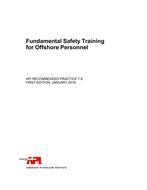No products
 View larger
View larger
API RP T-8
M00042480
New product
API RP T-8 Recommended Practice for Fundamental Safety Training for Offshore Personnel
standard by American Petroleum Institute, 01/01/2019
Full Description
This recommended practice provides guidance on the components of an effective training system related to offshore health, safety, and environment (HSE). A common safety training matrix is provided that outlines the fundamental recommended HSE training for offshore personnel. This matrix can be used in conjunction with other applicable recommended training and company-specific requirements.In stock
More info
Fundamental Safety Training for Offshore Personnel
API RECOMMENDED PRACTICE T-8 FIRST EDITION, JANUARY 2019
Special Notes
API publications necessarily address problems of a general nature. With respect to particular circumstances, local, state, and federal laws and regulations should be reviewed.
Neither API nor any of API's employees, subcontractors, consultants, committees, or other assignees make any warranty or representation, either express or implied, with respect to the accuracy, completeness, or usefulness of the information contained herein, or assume any liability or responsibility for any use, or the results of such use, of any information or process disclosed in this publication. Neither API nor any of API’s employees, subcontractors, consultants, or other assignees represent that use of this publication would not infringe upon privately owned rights.
API publications may be used by anyone desiring to do so. Every effort has been made by the Institute to assure the accuracy and reliability of the data contained in them; however, the Institute makes no representation, warranty, or guarantee in connection with this publication and hereby expressly disclaims any liability or responsibility for loss or damage resulting from its use or for the violation of any authorities having jurisdiction with which this publication may conflict.
API publications are published to facilitate the broad availability of proven, sound engineering and operating practices. These publications are not intended to obviate the need for applying sound engineering judgment regarding when and where these publications should be utilized. The formulation and publication of API publications is not intended in any way to inhibit anyone from using any other practices.
Any manufacturer marking equipment or materials in conformance with the marking requirements of an API standard is solely responsible for complying with all the applicable requirements of that standard. API does not represent, warrant, or guarantee that such products do in fact conform to the applicable API standard.
All rights reserved. No part of this work may be reproduced, translated, stored in a retrieval system, or transmitted by any means, electronic, mechanical, photocopying, recording, or otherwise, without prior written permission from the publisher. Contact the Publisher, API Publishing Services, 1220 L Street, NW, Washington, DC 20005.
Copyright © 2018 American Petroleum Institute
Foreword
The protection of life and the environment are fundamental objectives for offshore operations. The high risks associated with offshore operations demand a corresponding emphasis on safety and environmental protection. Offshore operators and contractors meet this challenge by developing and implementing policies, standards, practices, and/or procedures that provide the necessary protection for offshore personnel and the environment.
A major component of these safety and environmental protection measures efforts includes defining and providing proper training for all personnel who work offshore. An issue of particular concern is one of personnel transiting and/ or working offshore for the first time. Personnel who work in the offshore environment should receive fundamental safety training to assure that they have the knowledge, skills, and/or abilities necessary to safely perform their assigned roles and tasks.
The verbal forms used to express the provisions in this specification are as follows:
the term “shall” denotes a minimum requirement in order to conform to the specification;
the term “should” denotes a recommendation or that which is advised but not required in order to conform to the specification;
the term “may” is used to express permission or a provision that is optional;
the term “can” is used to express possibility or capability.
Nothing contained in any API publication is to be construed as granting any right, by implication or otherwise, for the manufacture, sale, or use of any method, apparatus, or product covered by letters patent. Neither should anything contained in the publication be construed as insuring anyone against liability for infringement of letters patent.
This document was produced under API standardization procedures that ensure appropriate notification and participation in the developmental process and is designated as an API standard. Questions concerning the interpretation of the content of this publication or comments and questions concerning the procedures under which this publication was developed should be directed in writing to the Director of Standards, American Petroleum Institute, 1220 L Street, NW, Washington, DC 20005. Requests for permission to reproduce or translate all or any part of the material published herein should also be addressed to the director.
Generally, API standards are reviewed and revised, reaffirmed, or withdrawn at least every five years. A one-time extension of up to two years may be added to this review cycle. Status of the publication can be ascertained from the API Standards Department, telephone (202) 682-8000. A catalog of API publications and materials is published annually by API, 1220 L Street, NW, Washington, DC 20005.
Suggested revisions are invited and should be submitted to the Standards Department, API, 1220 L Street, NW, Washington, DC 20005, standards@api.org.
iii
Contents
Page
Scope 1
Normative References 1
Terms and Definitions 1
Determination of Training Needs 1
General 1
Training Needs Considerations 1
Identification of Training Needs 2
Components of Training Systems 2
General 2
Identification of Learning and Performance Objectives 3
Methods of Delivery 4
Frequency and Scheduling 6
Qualifications for Trainers and Training Providers 7
Training Records 8
Sustainability and Continual Improvement 9
Evaluating Training 10
General 10
Training Assessment 10
Training Effectiveness 12
Remediation 12
Annex A (informative) Recommended Training and Frequencies 13
Bibliography 15
Tables
A.1 Recommended Fundamental Safety Training Matrix 14
v

